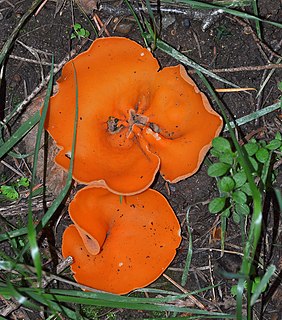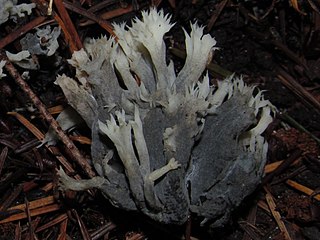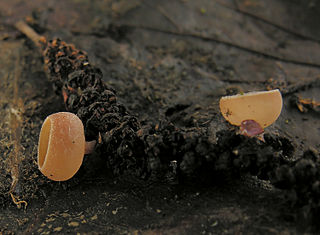
Aleuria aurantia is a widespread ascomycete fungus in the order Pezizales. The brilliant orange, cup-shaped ascocarps often resemble orange peels strewn on the ground, giving this species its common name.

Karl Wilhelm Gottlieb Leopold Fuckel was a German botanist who worked largely on fungi.

Exobasidium is a genus of fungi in the family Exobasidiaceae. The genus has a widespread distribution, especially in northern temperate regions, and contains about 50 species. Many of the species in this genus are plant pathogens that grow on Ericaceae.
The Didymosphaeriaceae are a family of fungi in the order Pleosporales. The family was erected by Anders Munk in 1953.

The Sarcoscyphaceae are a family of cup fungi in the order Pezizales. Members of the Sarcoscyphaceae are cosmopolitan in distribution, found in both tropical and temperate regions.

Humaria is a genus of fungi in the family Pyronemataceae. The genus is widespread in northern temperate areas, and contains 16 species. The genus was circumscribed by Karl Wilhelm Gottlieb Leopold Fuckel in 1870.

Humaria hemisphaerica, commonly known as the hairy fairy cup or the brown-haired fairy cup, is a species of fungi in the family Pyronemataceae. This mycorrhizal fungus is recognized by its white inner surface and hairy brown outer surface. The specific epithet is derived from the Latin word hemisphaericum, meaning half a sphere.
Plagiostoma is a genus of fungi in the family Gnomoniaceae. The genus contains 22 species.
Linospora is a genus of fungi in the family Gnomoniaceae. The genus contains four species.
Gnomoniella is a genus of fungi in the family Gnomoniaceae. The genus contains 13 species. Gnomoniopsis is a genus of fungi in the family Gnomoniaceae including:
Gibberidea is a genus of fungi in the class Dothideomycetes. The relationship of this taxon to other taxa within the class is unknown. The genus was named by German mycologist Karl Wilhelm Gottlieb Leopold Fuckel in 1870.

Rhopographus is a genus of fungi in the class Dothideomycetes. The relationship of this taxon to other taxa within the class is unknown.

Plectania is a genus of fungi in the family Sarcosomataceae. There are 15 species in the genus, which have a widespread distribution, especially in northern temperate areas. Plectania was circumscribed by German botanist Karl Wilhelm Gottlieb Leopold Fuckel in 1870.

Pseudoplectania is a genus of fungi in the family Sarcosomataceae. The genus contains 12 species. Pseudoplectania ryvardenii was described in 2012, while Pseudoplectania carranzae was transferred to the genus in 2013.
Karstenia is a genus of fungi in the order Rhytismatales. The relationship of this taxon to other taxa within the order is unknown, and it has not yet been placed with certainty into any family.

Helminthosphaeria is a genus of fungi in the family Helminthosphaeriaceae (Ascomycota).
Cephalotheca is a genus of fungi in the Cephalothecaceae family of the Ascomycota. The relationship of this taxon to other taxa within the Sordariomycetes class is unknown, and it has not yet been placed with certainty into any order.

Pseudoplectania nigrella, commonly known as the ebony cup, the black false plectania, or the hairy black cup, is a species of fungi in the family Sarcosomataceae. The fruit bodies of this saprobic fungus are small blackish cups, typically up to 2 cm (0.8 in) broad, that grow in groups on soil, often amongst pine needles and short grass near coniferous trees. Pseudoplectania nigrella has a worldwide distribution, and has been found in North America, the Caribbean, Britain, Europe, India, Madagascar, New Zealand, and Japan. The fungus produces a unique chemical compound, plectasin, that has attracted research interest for its ability to inhibit the growth of the common human pathogenic bacterium Streptococcus pneumoniae.

Otidea is a genus of fungi in the family Pyronemataceae. The genus is widely distributed in northern temperate regions.

Ciboria amentacea, commonly known as the catkin cup, is a species of ascomycete fungus in the family Sclerotiniaceae. It is widespread in Europe and North America, where it grows on catkins of willow and alder. The species was first described by Giovanni Battista Balbis in 1804 as Peziza amentacea. Karl Wilhelm Gottlieb Leopold Fuckel transferred it to Ciboria in 1870.











